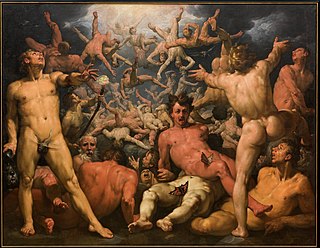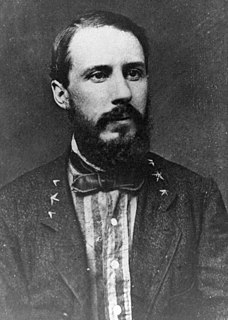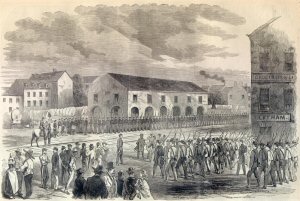Lee Passarella is a writer and senior literary editor of the Atlanta Review . His long narrative poem Swallowed Up In Victory (Burd Street Press, 2002) is based on the American Civil War. [1] [2]
Lee Passarella is a writer and senior literary editor of the Atlanta Review . His long narrative poem Swallowed Up In Victory (Burd Street Press, 2002) is based on the American Civil War. [1] [2]

The American Civil War was a civil war in the United States between the Union and the Confederacy. The central cause of the war was the status of slavery, especially the expansion of slavery into territories acquired as a result of the Louisiana Purchase and the Mexican–American War. On the eve of the Civil War in 1860, four million of the 32 million Americans (~13%) were enslaved black people, almost all in the South.

The Battle of Gettysburg was fought July 1–3, 1863, in and around the town of Gettysburg, Pennsylvania, by Union and Confederate forces during the American Civil War. In the battle, Union Maj. Gen. George Meade's Army of the Potomac defeated attacks by Confederate Gen. Robert E. Lee's Army of Northern Virginia, halting Lee's invasion of the North. The battle involved the largest number of casualties of the entire war and is often described as the war's turning point due to the Union's decisive victory and concurrence with the Siege of Vicksburg.

In Norse mythology, a valkyrie is one of a host of female figures who guide the souls of deceased Nordic soldiers in one of two paths. Selecting among half of those who die in battle go to Fólkvangr, Freyja's afterlife, the other half go to Gods hall called Valhalla. There, the deceased warriors become einherjar. When the einherjar are not preparing for the events of Ragnarök, the valkyries bear them mead. Valkyries also appear as lovers of heroes and other mortals, where they are sometimes described as the daughters of royalty, sometimes accompanied by ravens and sometimes connected to swans or horses.

In Greek mythology, the Titanomachy was a ten-year series of battles fought in Thessaly, consisting of most of the Titans fighting against the Olympians and their allies. This event is also known as the War of the Titans, Battle of the Titans, Battle of the Gods, or just the Titan War. The war was fought to decide which generation of gods would have dominion over the universe; it ended in victory for the Olympian gods.

The Battle of Antietam, or Battle of Sharpsburg particularly in the Southern United States, was a battle of the American Civil War fought on September 17, 1862, between Confederate Gen. Robert E. Lee's Army of Northern Virginia and Union Gen. George B. McClellan's Army of the Potomac near Sharpsburg, Maryland and Antietam Creek. Part of the Maryland Campaign, it was the first field army–level engagement in the Eastern Theater of the American Civil War to take place on Union soil. It remains the bloodiest day in American history, with a combined tally of 22,717 dead, wounded, or missing.

Edward Porter Alexander was an American military engineer, railroad executive, planter, and author. He served first as an officer in the United States Army and later, during the American Civil War (1861–1865), in the Confederate Army, rising to the rank of brigadier general.

Raphael Semmes was an officer in the Confederate Navy during the American Civil War. Until then, he had been a serving officer in the US Navy from 1826 to 1860.

The Battle of South Mountain—known in several early Southern accounts as the Battle of Boonsboro Gap—was fought on September 14, 1862, as part of the Maryland campaign of the American Civil War. Three pitched battles were fought for possession of three South Mountain passes: Crampton's, Turner's, and Fox's Gaps. Maj. Gen. George B. McClellan, commanding the Union Army of the Potomac, needed to pass through these gaps in his pursuit of Confederate General Robert E. Lee's precariously divided Army of Northern Virginia. Although the delay bought at South Mountain would allow him to reunite his army and forestall defeat in detail, Lee considered termination of the Maryland Campaign at nightfall.
Eric Drooker is an American painter, graphic novelist, and frequent cover artist for The New Yorker. He conceived and designed the animation for the film Howl (2010).

The Lost Cause of the Confederacy is an American pseudohistorical negationist mythology that claims the cause of the Confederate States during the American Civil War was just, heroic, and not centered on slavery. It has continued to influence racism, gender roles and religious attitudes in the South to the present day.

There is widespread disagreement among historians about the turning point of the American Civil War. A turning point in this context is an event that occurred during the conflict after which most modern scholars would agree that the eventual outcome was inevitable. While the Battle of Gettysburg in July 1863 is the event most widely cited as the military climax of the American Civil War, there were several other decisive battles and events throughout the war which have been proposed as turning points. These events are presented here in chronological order. Only the positive arguments for each are given.
The most common name for the American Civil War in modern American usage is simply "The Civil War". Although rarely used during the war, the term "War Between the States" became widespread afterward in the Southern United States. During and immediately after the war, Northern historians often used the terms "War of the Rebellion" and "Great Rebellion", and the Confederate term was "War for Southern Independence", which regained some currency in the 20th century but has again fallen out of use. The name "Slaveholders' Rebellion" was used by Frederick Douglass and appears in newspaper articles. Also in the 20th century, the term "War of Northern Aggression" developed under the Lost Cause of the Confederacy movement by Southern history revisionists, with attempts to reimagine the American Civil War narrative negatively and to preserve Confederate legacy. "Freedom War" is used to celebrate the war's effect of ending slavery. In several European languages, the war is called "War of Secession".

The Civil War: A Narrative (1958–1974) is a three volume, 2,968-page, 1.2 million-word history of the American Civil War by Shelby Foote. Although previously known as a novelist, Foote is most famous for this non-fictional narrative history. While it touches on political and social themes, the main thrust of the work is military history. The individual volumes include Fort Sumter to Perryville (1958), Fredericksburg to Meridian (1963), and Red River to Appomattox (1974).

Edward Burd Grubb Jr. was a Union Army colonel and regimental commander in the American Civil War. He served in three regiments and commanded two of them. In recognition of his service, in 1866, he was nominated and confirmed for appointment to the grade of brevet brigadier general of volunteers, to rank from March 13, 1865. He was later appointed by President Benjamin Harrison as United States Ambassador to Spain. He was also a noted foundryman, business owner and New Jersey politician who was close to Woodrow Wilson.

The city of Winchester, Virginia, and the surrounding area, were the site of numerous battles during the American Civil War, as contending armies strove to control the lower Shenandoah Valley. Winchester changed hands more often than any other Confederate city.
The American Civil War bibliography comprises books that deal in large part with the American Civil War. There are over 60,000 books on the war, with more appearing each month. Authors James Lincoln Collier and Christopher Collier stated in 2012, "No event in American history has been so thoroughly studied, not merely by historians, but by tens of thousands of other Americans who have made the war their hobby. Perhaps a hundred thousand books have been published about the Civil War."
The following list is a bibliography of American Civil War Confederate military unit histories and are generally available through inter-library loan. More details on each book are available at WorldCat. For an overall national view, see Bibliography of the American Civil War. For histories of the Union, see Bibliography of American Civil War Union military unit histories. For a guide to web sources see: Carter, Alice E.; Jensen, Richard. The Civil War on the Web: A Guide to the Very Best Sites—Completely Revised and Updated (2003).
The American Civil War bibliography comprises books that deal in large part with the American Civil War. There are over 60,000 books on the war, with more appearing each month. There is no complete bibliography to the war; the largest guide to books is over 40 years old and lists over 6,000 titles.
Walbrook D. Swank Walbrook "Wally" Davis Swank was a World War II officer and a noted historical author.

The Stonewall Jackson Monument in Richmond, Virginia, was erected in honor of Thomas Jonathon ‘Stonewall’ Jackson, a Confederate general. The monument was located at the centre of the crossing of Monument Avenue and North Arthur Ashe Boulevard, in Richmond, Virginia. The bronze equestrian statue was unveiled in 1919. Along this avenue is other statues including Robert E. Lee, J. E. B. Stewart, Jefferson Davis, Matthew Maury and more recently Arthur Ashe. Thomas Jackson is best known as one of Robert E. Lee's most trusted commanders throughout the early period of the American Civil War between Southern Confederate states and Northern Union states. He rose to prominence after his vital role in the Confederate victory at the First Battle of Bull Run in July 1861, continuing to command troops until his untimely death on May 10, 1863, after falling fatally ill following the amputation of his wounded arm.